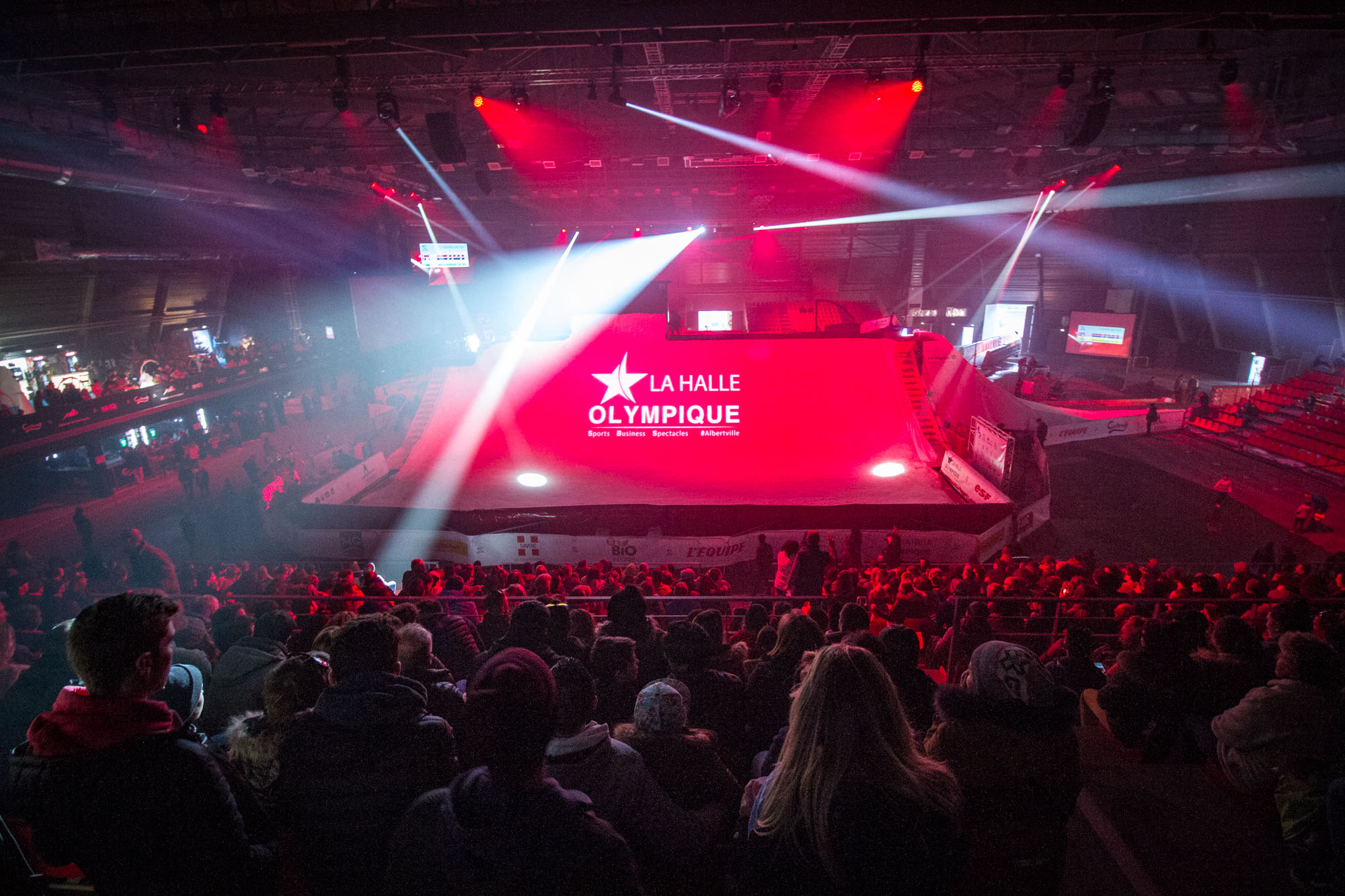
Event News
The White Festival: Stadium Skiing Debuts in Albertville
When I first heard about The White Festival being planned in Albertville’s Olympic Hall, I thought the same as a lot of you probably did: “I have to see this shit.”
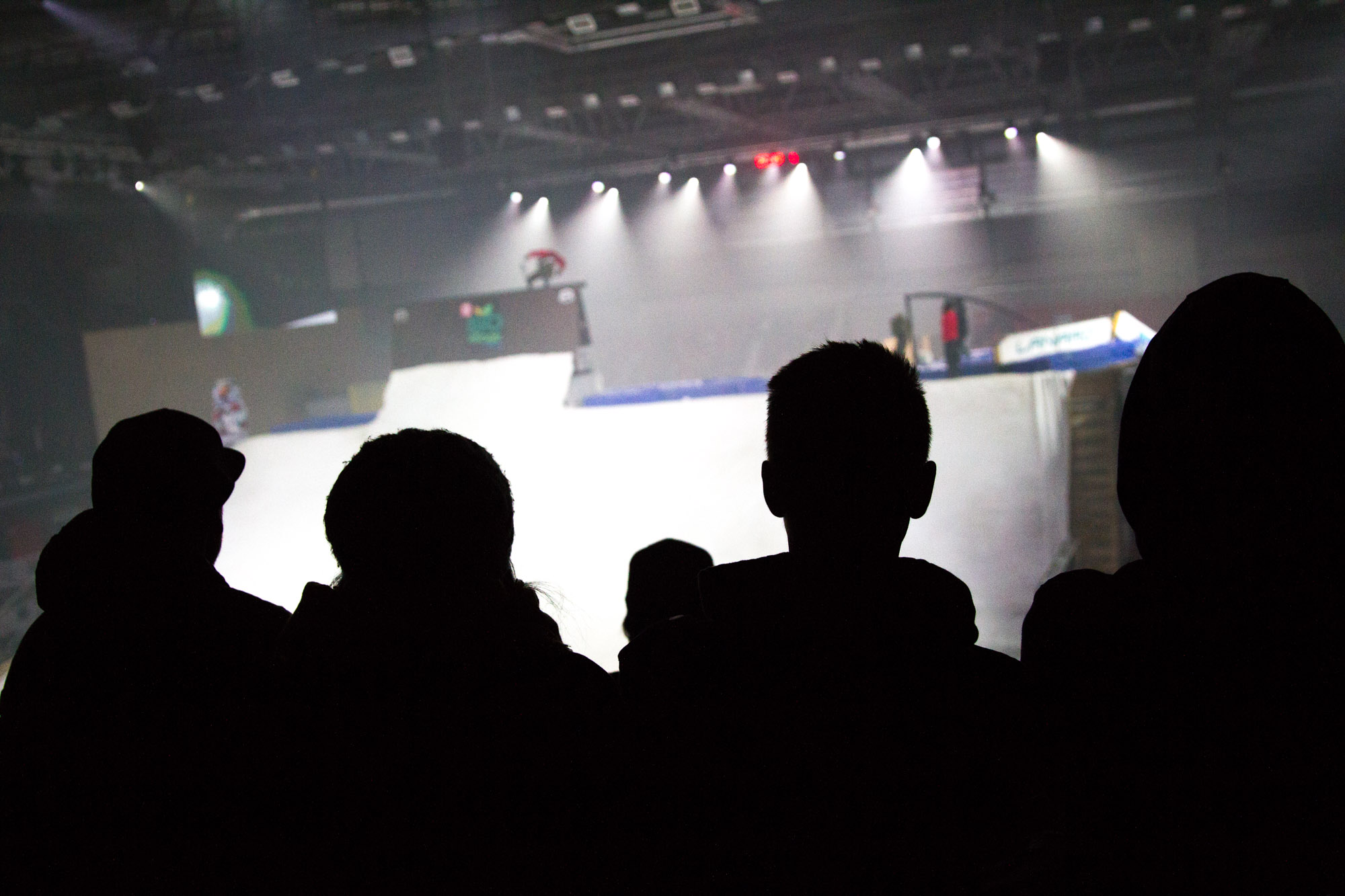
The White Festival packed Albertville´s Olympic Hall for an unusual spectacle.
The organizers of the festival had given themselves a tremendous task: build a working snowpark setup on flat ground in a public arena, and propel riders into the features with winches. And not just one winch, either—four winches, arrayed around the Olympic Hall like spokes on a wheel. And to make the inrun long enough, the riders would actually have to start outside the building itself. Standing in the parking lot, they’d grab the winch handlebars, wait for the signal, then be flung at high speed down the Snowflex inrun, through open double doors, and into an arena full of cheering fans. That was the plan, anyway.
The whole concept would never have been possible without the enthusiastic involvement of the Olympic Hall itself, whose managers had approached French freeski star Marie Martinod to ask about developing a “season opening” on-snow event in their facility. Marie quickly reached out to freeski event organizer Raf Regazzoni of BUG Visionaries and architect Lao Chazelas of INOUT Skateparks & Ramps to make the dream of an indoor ski event a reality.
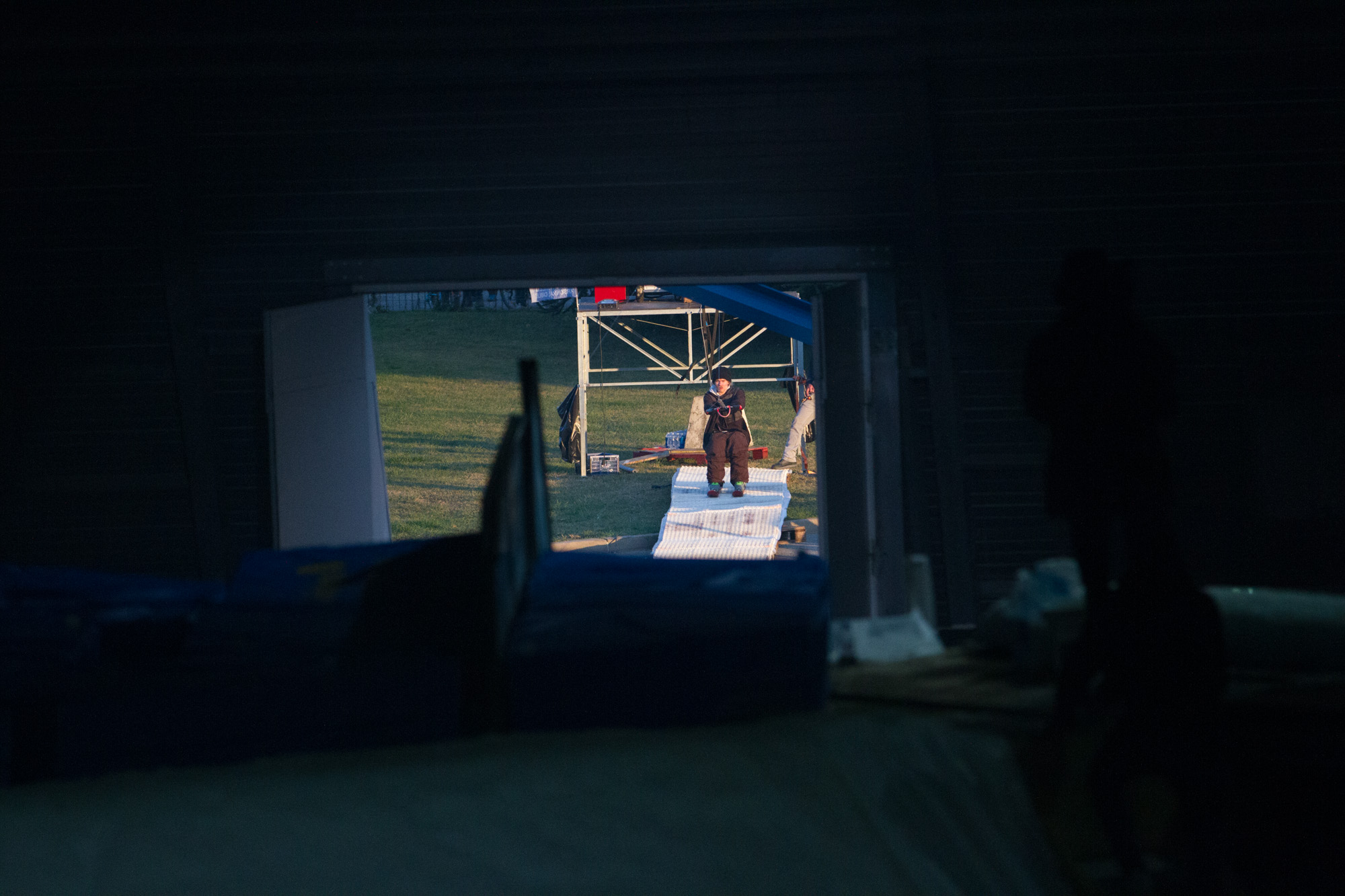
Antti Ollila, ready to "drop."
“We’ve been planning this for two years,” said Regazzoni. “A year ago we finished the concept and the design for the feature. The city of Albertville approved the budget and the concept, and then we had to make it real. The snow, scaffolding, shaping—that was all hard, but it wasn’t the hardest part. The critical part was the winch.”
During the qualifying rounds on Friday, it was apparent that this concept, awesome as it was, was no easy task to bring to life. The winches had to run in coordination, firing riders in from opposite ends of the hall like clockwork—a process that took refinement, left a bit of waiting time between hits, and had riders running frantically around the hall from inrun to inrun. Luckily the winches were well dialed in speed-wise, and most of the riders, even those new to winching, quickly got the hang of it.
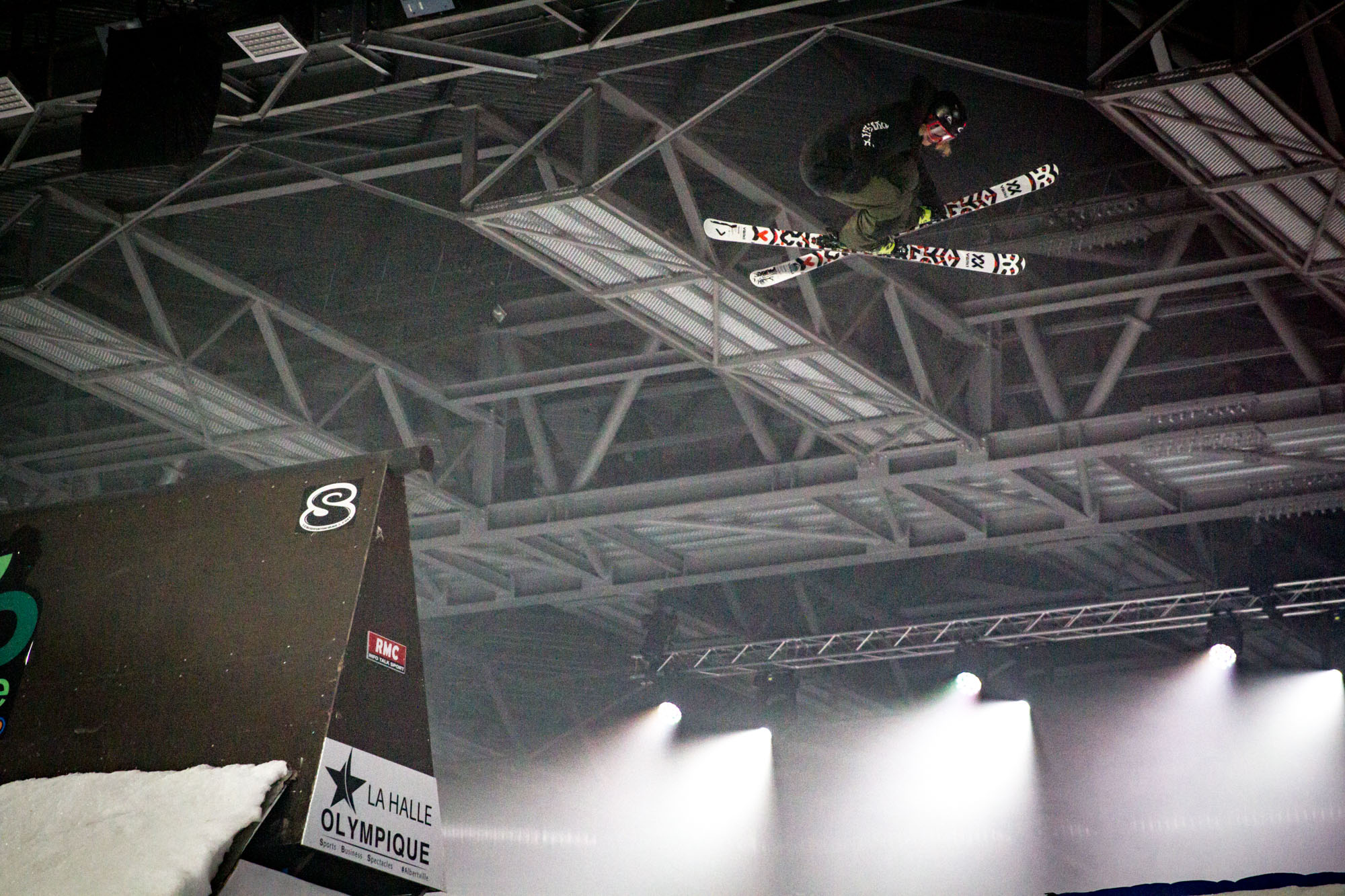
Finn Bilious was one part of a New Zealand squad that also included Jossi Wells and Nico Porteous.
Spectating also included a learning curve. At any moment, a rider might come flying in through a door and off of a feature, with barely enough time to turn your head to watch the action. Learning how to look in the right direction meant deciphering the pattern the winches were running on, and even watching the winch cables for telltale signs, a jiggle of the cord that would give away which one would fire next. (I suppose speaking French so I could understand the announcer would have helped, too.) The splay of inruns around the hall made moving from place to place a challenge—one spectator area was accessible only via a a scaffolding “overpass” over one of the winch lines—and a constantly rising puddle of meltwater around the venue didn’t help things, either.
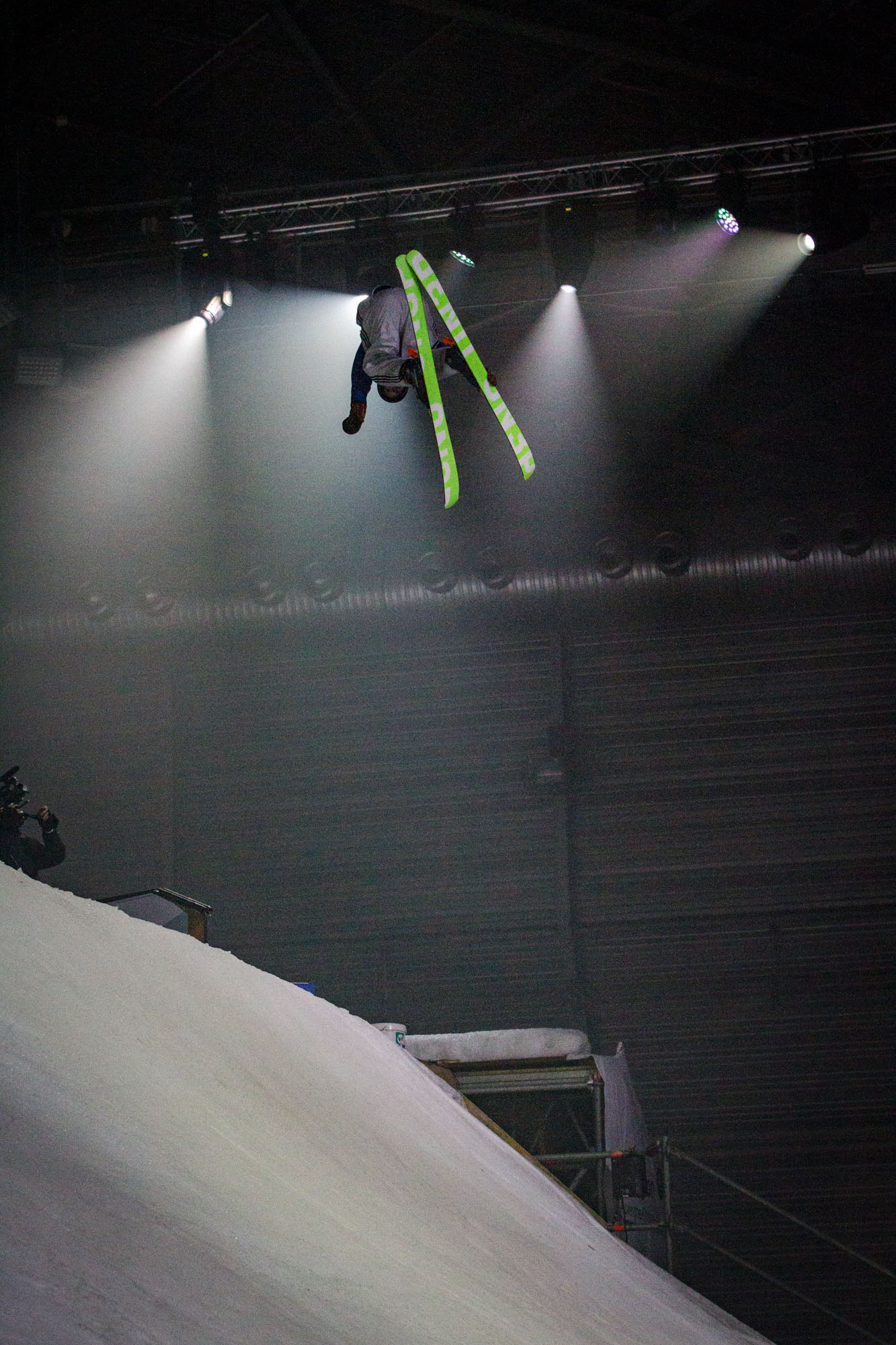
"Skiman" Magnus Granèr from the The Bunch was one of the invite list´s more unusual names—and of course he killed it.
Despite the obvious challenges of running an event like this, things actually went surprisingly well. All of the features worked flawlessly, the winches too for the most part, and by the time that qualifiers wrapped up, it was evident that we’d be in for a real show during Saturday’s final.
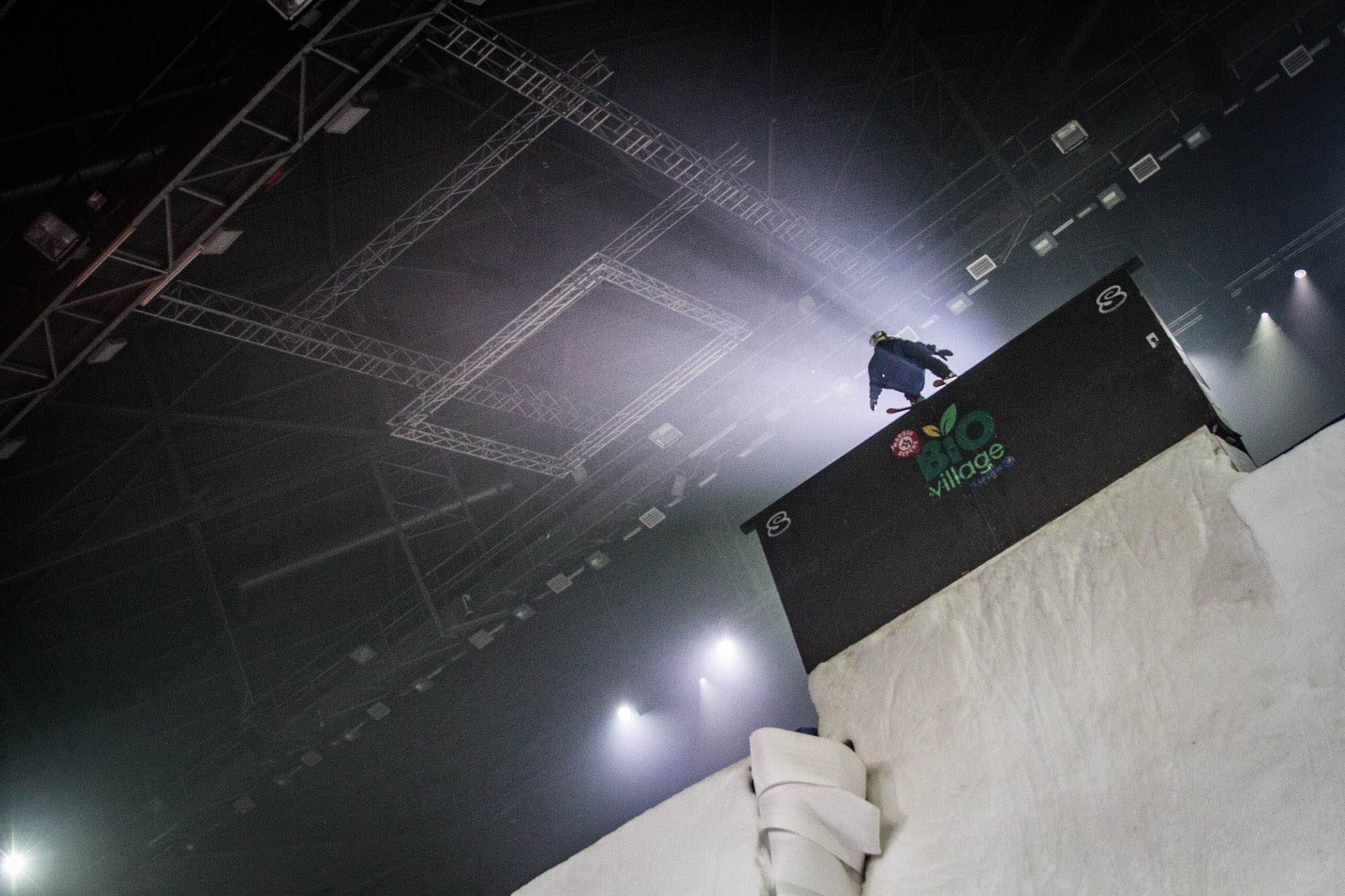
Accidental Renaissance: Phil Casabon in a moment of glory on the wallride.
Still, the question remained: would people come? This was a first-year event, and Albertville is a small town. Adding to the problem, Saturday was a day of “yellow vest” blockades in France to protest a rise in fuel prices. Vest-clad protesters swarmed public roads, shutting down motorized travel across the country, and leaving The White Festival organizers wondering if the roads to Albertville would even be passable on Saturday.
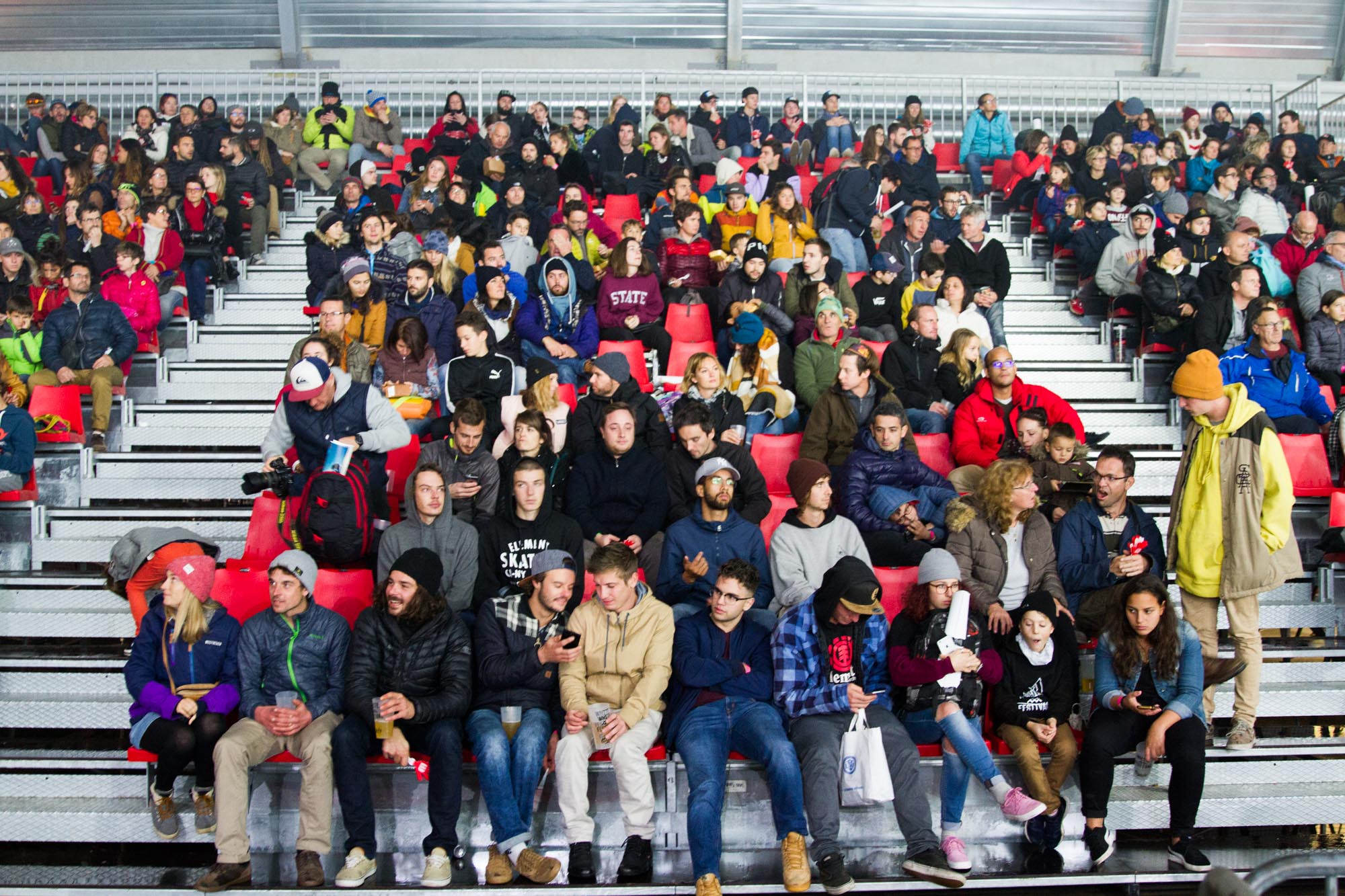
If you build it, they will come.
About an hour before the semi-finals were slated to begin, the doors to the venue opened to the public, and any concerns about attendance were quickly laid to rest as thousands of excited fans began pouring into the arena. You gotta hand it to the French—they are some of the most diehard freeski fans in Europe, and can always be counted on to turn up for a spectacle. With a packed house, and the winch routine now dialed in after a day of qualifiers, it was time to put on a show.
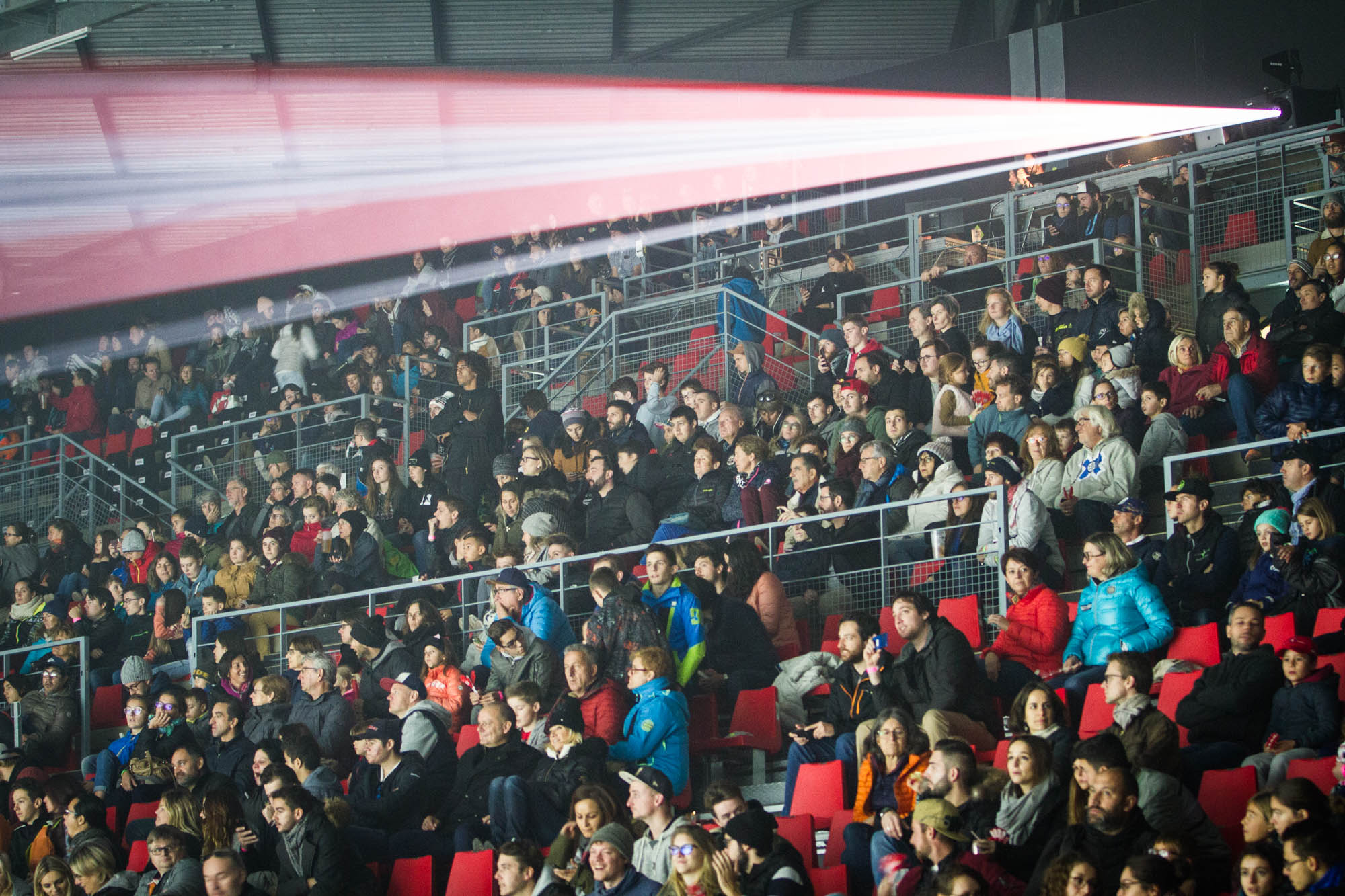
A full house turned out to cheer on their ski heroes.
Eight teams composed of one skier and snowboarder each had battled their way from the qualifiers into the semis. The teams rotated around from winch to winch, getting just one hit on each section of the course, and one “redo” option on their pick of one of the sections. The sections were labelled Hip, Jib, Wall and Transfer—pretty straightforward, the “transfer” being a straight jump up and over the central spine, or an option to hit the wall from the left side.
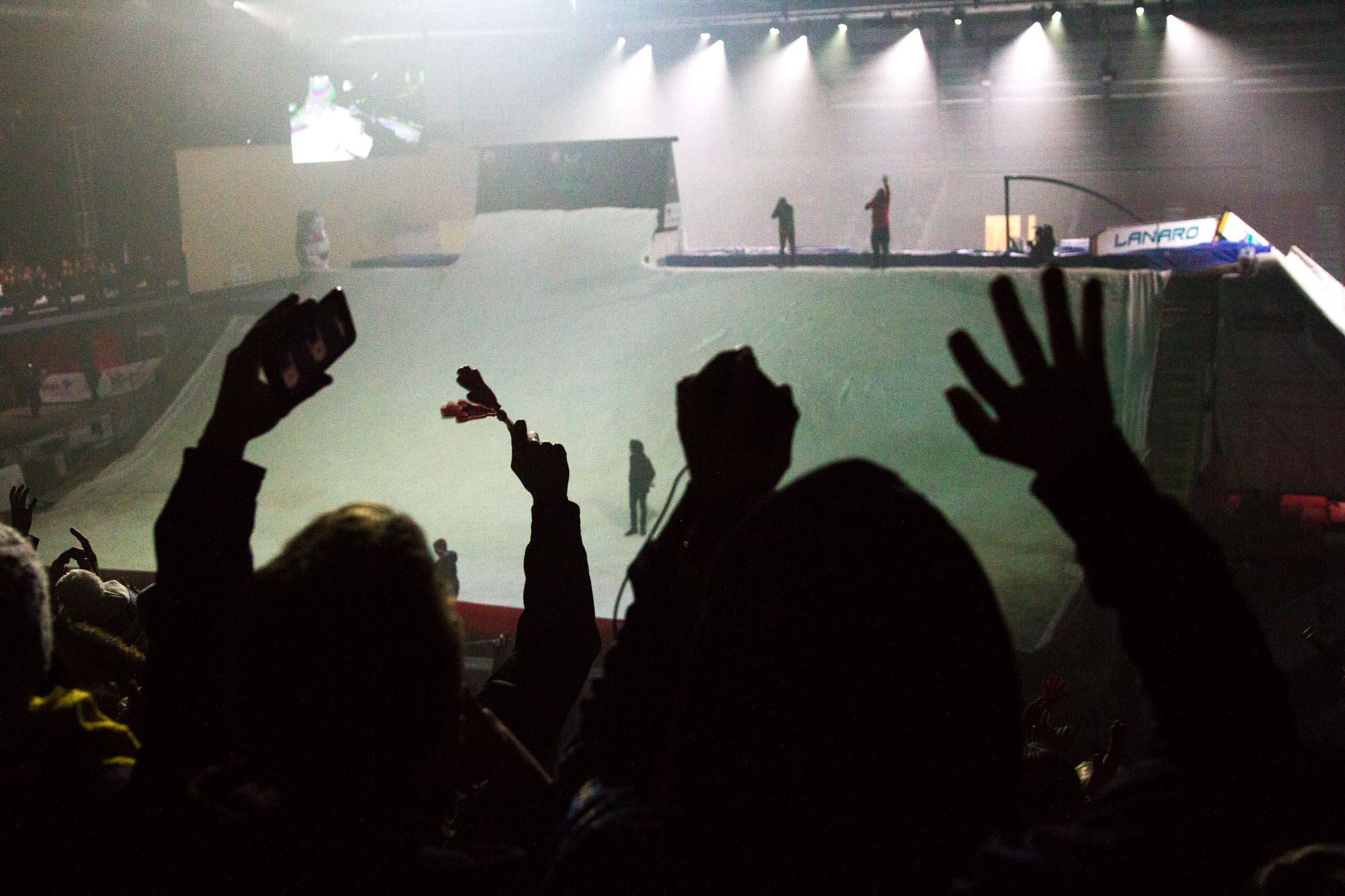
You gotta hand it to the French: they love this shit.
Between the semis and the finals, a “Best Trick” session provided for rapid-fire action on the Transfer setup and the evenings only doubles on skis: Jesper Tjäder’s double backflip late 180, Nico Porteous’ switch dub 10, and a double cork 7 from his New Zealand countryman Finn Bilious. Meanwhile Jossi Wells put on a style clinic with smooth air to fakies on the wall, Henrik Harlaut stomped a fresh nosebutter 5 on the wall, and Jesper Tjäder somehow pulled off (loose but lit) a 450 on, switch up, 360 off the wallride.
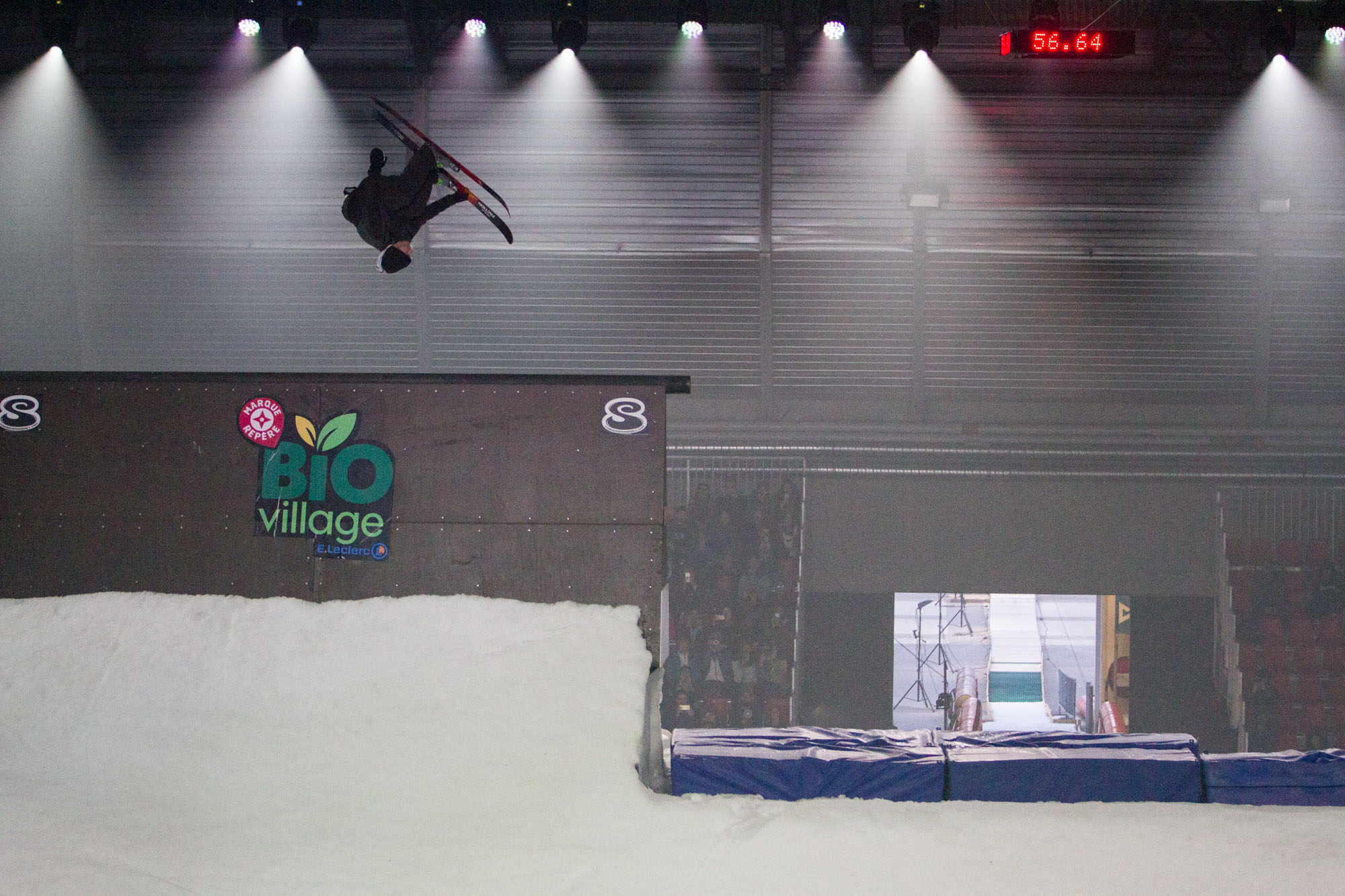
Wall god Antti Ollila.
Finals time: only four teams left standing from an original field of twelve. Eliminated: big names like Jossi Wells, Henrik Harlaut, Phil Casabon. Remaining: Team Europe 1 (Tom Ritsch and snowboarder Ethan Morgan), Team US (Taylor Seaton and Brandon Davis), Team Finland (Antti Ollila and Roope Tonteri) and holding it down for the home crowd, Team France (Hugo Laugier and Sacha Moretti).
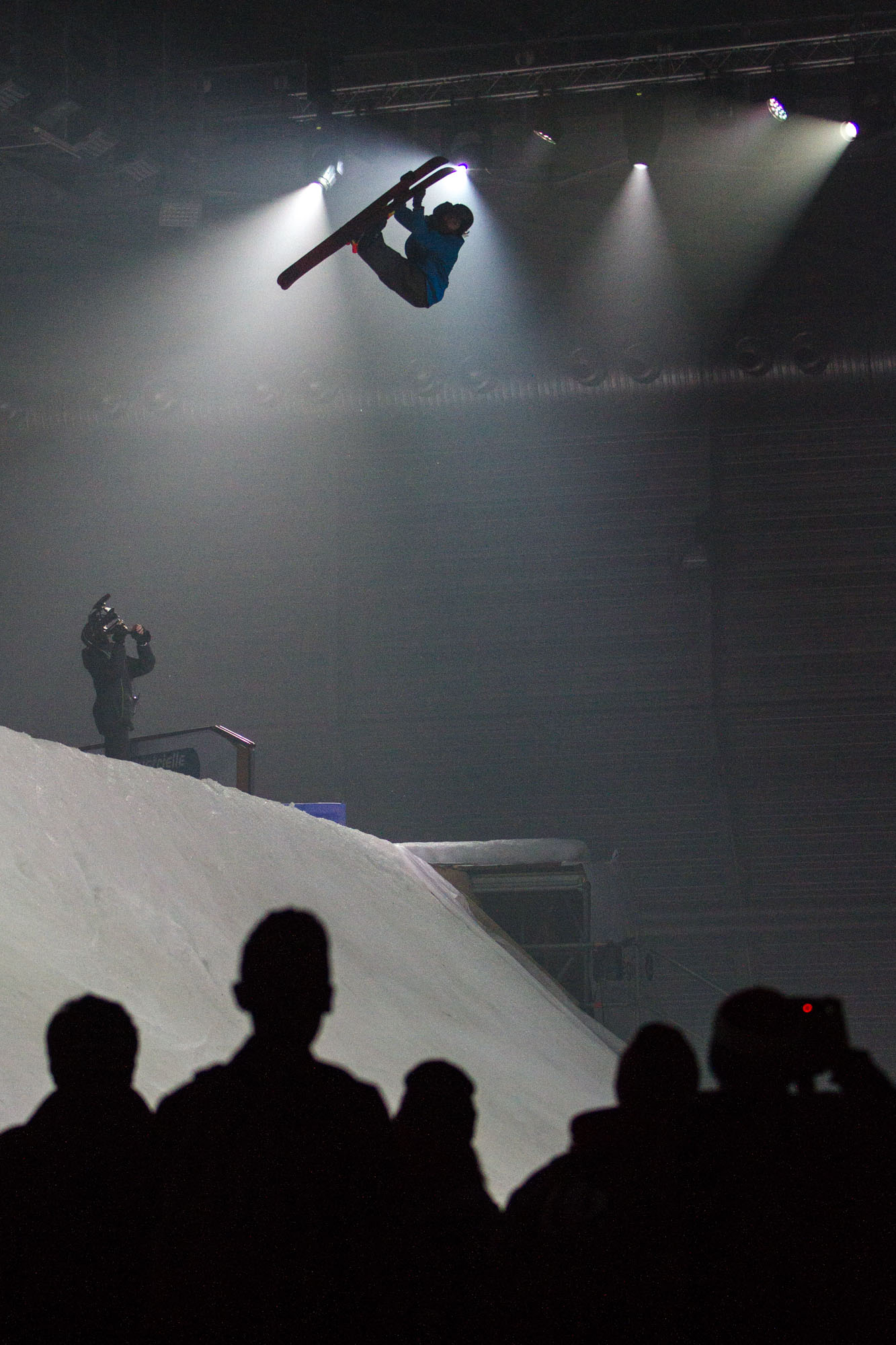
Hugo Laugier was on fire all night with tricks like this huge cork 7 truckdriver.
All of the teams in the finals brought the heat. Hugo Laugier was obviously hyped up to be representing France, and was going massive with immaculately clean tricks. Taylor Seaton, who had smashed his hand in training the day before and wasn’t even sure if he could hold the winch, was in the mix with his considerable bag of transition tricks. Ever-consistent Tom Ritsch from Austria was on his game as well; but in the end it was Finnish wizard Antti Ollila who, with the help of his snowboard counterpart, conjured up the win with an amazing all-round performance on all of the different features.
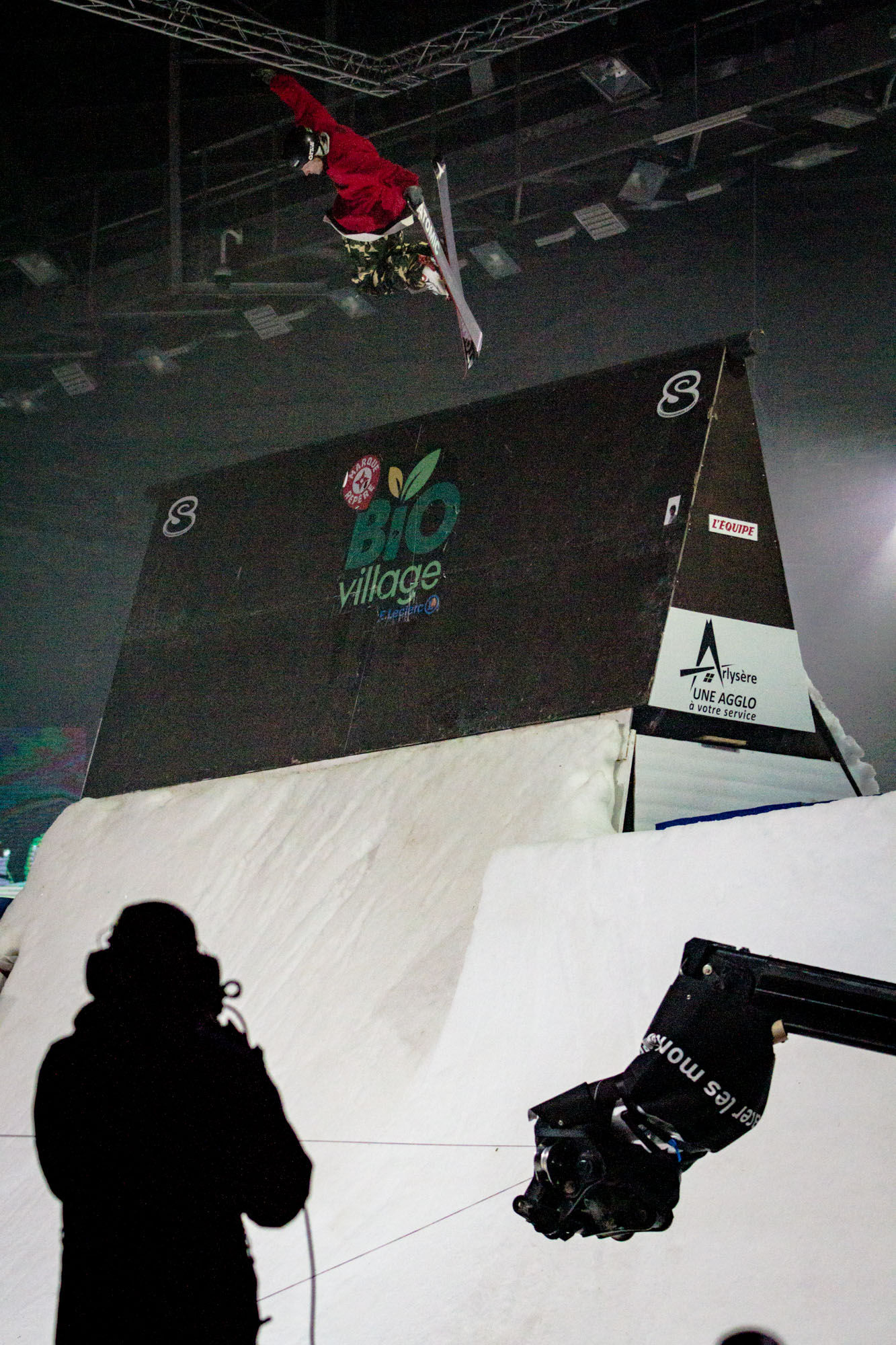
Taylor Seaton is never one to miss a blunt grab.
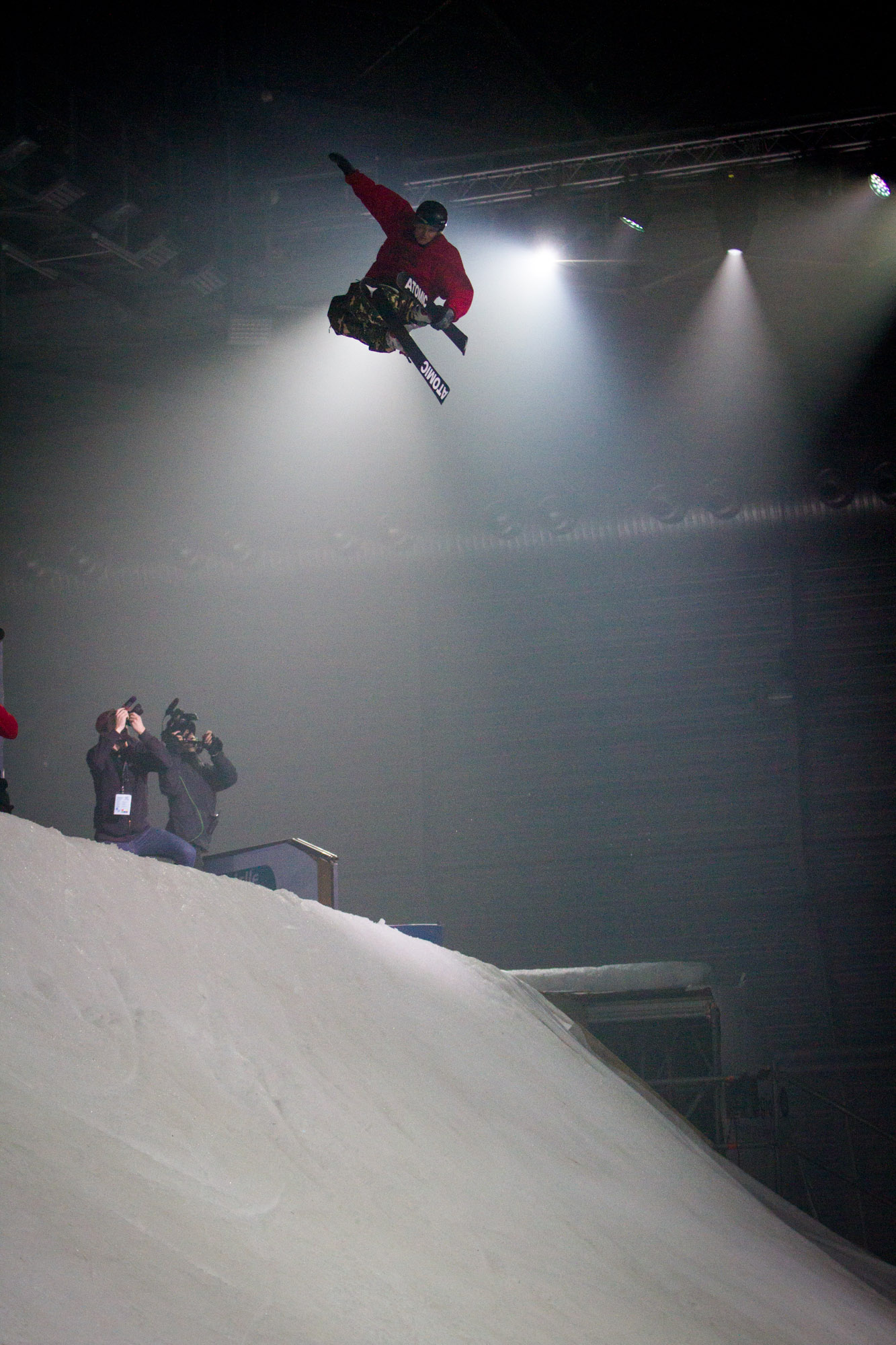
Seaton doesn´t "grab safety" so much as he "manhandles his ski into utter submission."
“I had no expectations at all, but I had a good feeling about this one,” said Ollila, whose winning runs included a cork 7 blunt on the hip, a backslide blind 450 reverse mute out in the jibs, a rodeo 5 on the wall from the “transfer” winch and an alley-oop unnatural flair safety on the wall.
“This whole thing pushed everyone’s limits,” he continued. “For example, in the final we hadn’t hit some of the spots in like three hours, and then you had to winch in and do a trick first try. That was gnarly.”
“It’s such a crazy idea, doing this indoor and winching in. I’m super impressed with the organization and how they made everything happen, from building the setup to the livestream. It was a lot of work and planning for sure.”
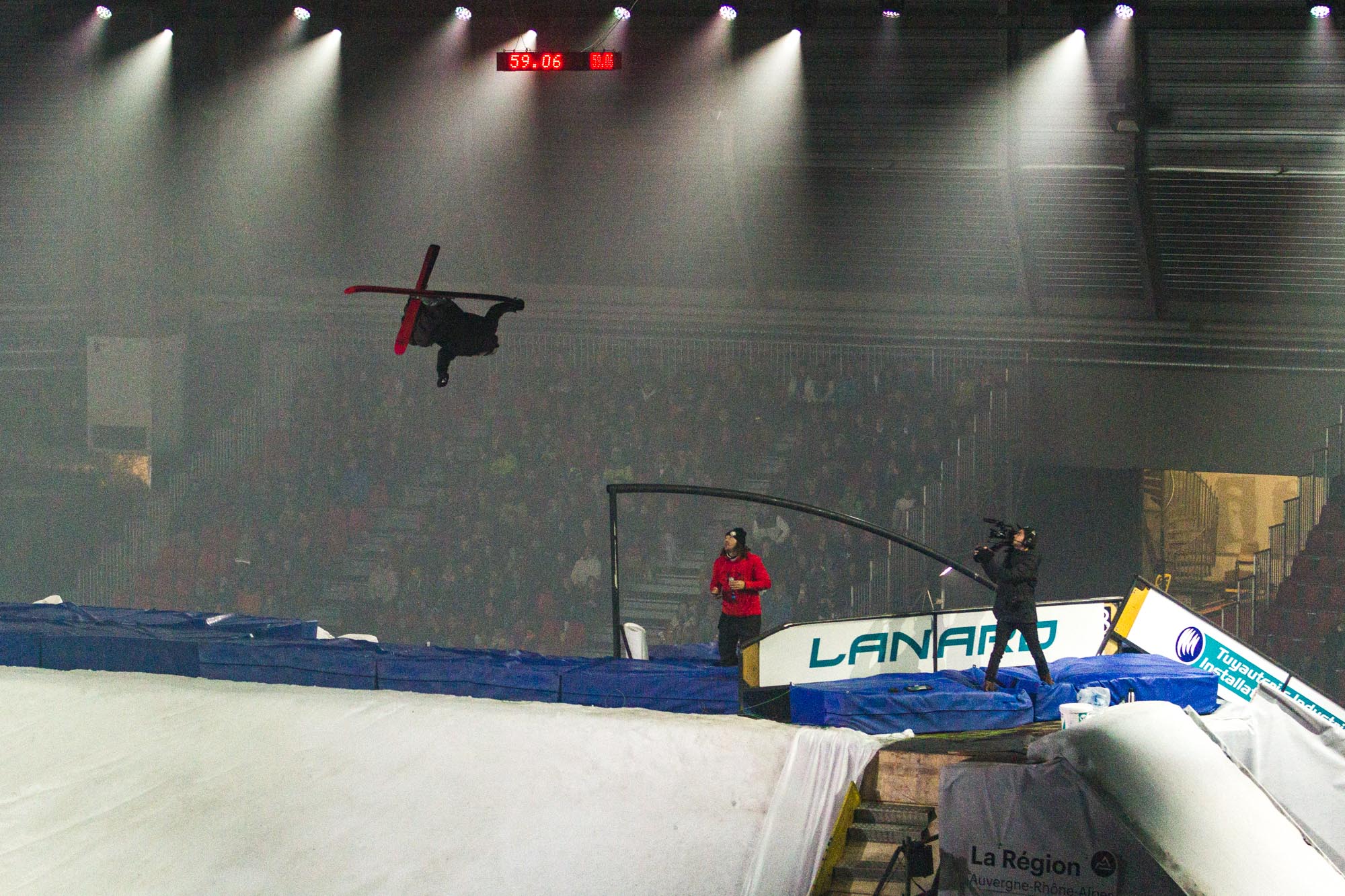
Antti Ollila dropped steeze on all of the different features. Here, a cork 7 blunt on the hip.
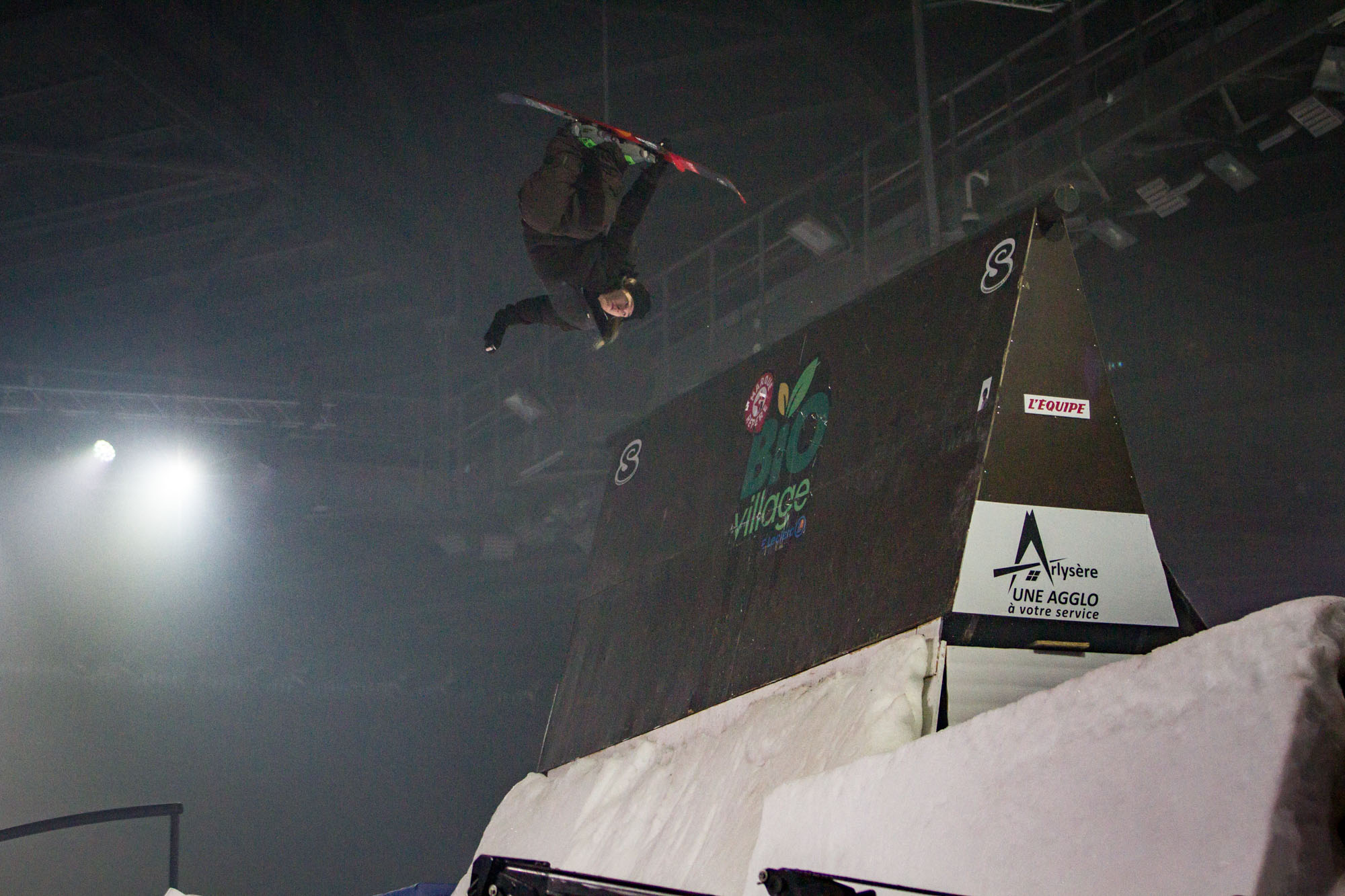
Some riders had trouble coming up with tricks for the wall. Not Ollila, here with an alley-oop unnatural flair.
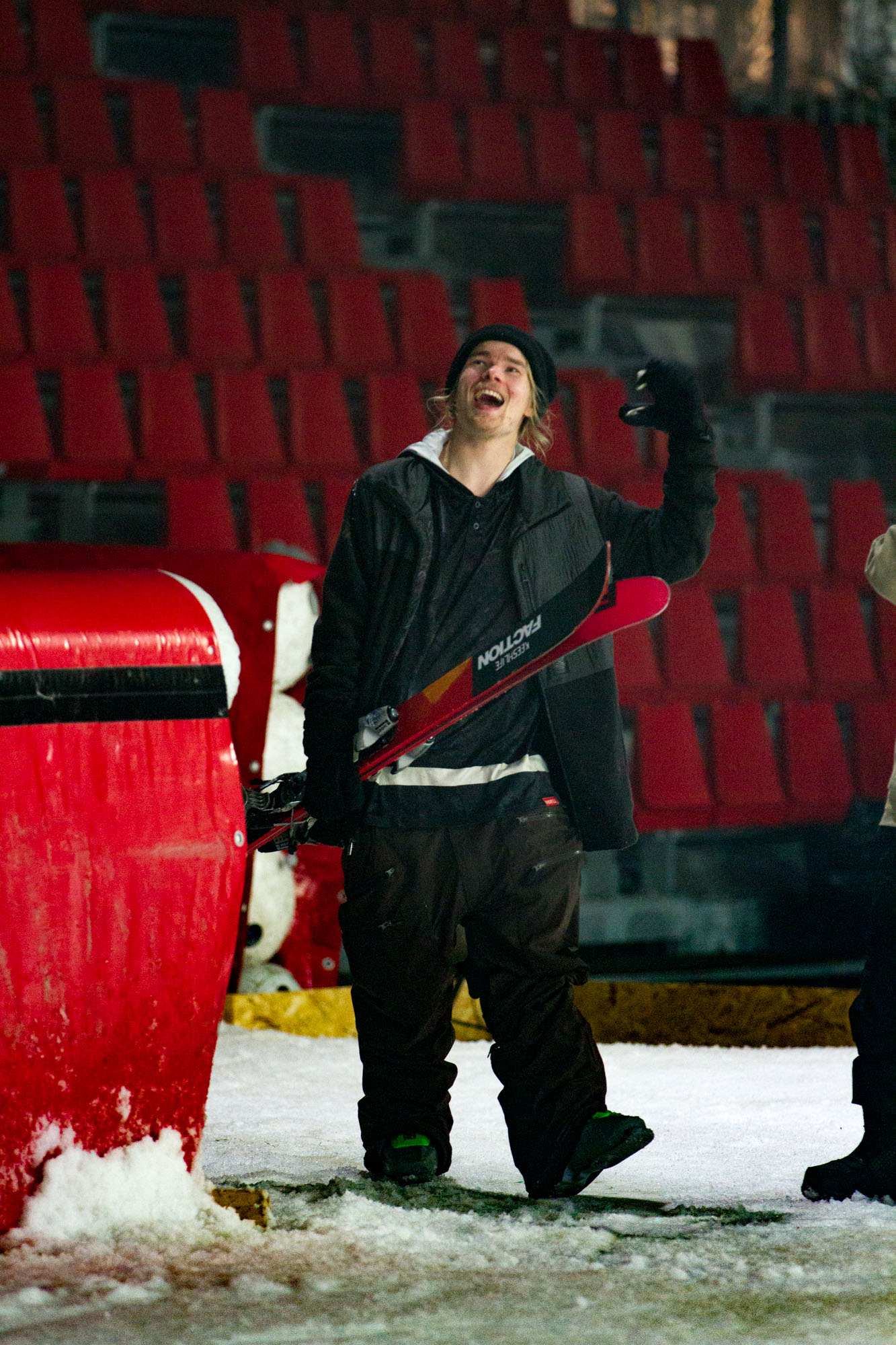
Ollila´s stoke was the biggest.
On the women’s side, three ladies stepped into the ring: White Festival mascot Marie Martinod, French styler Coline Ballet-Baz, and Olympic gold medalist Sarah Hoefflin. Martinod showed she’s still got it with some massive airs on the hip and Ballet-Baz laced up the best backslide I’ve ever seen a woman do, but the judges went with Hoefflin, one of the few riders to hit the transfer jump switch with smooth switch cork 5 safeties, as the evening’s winner.
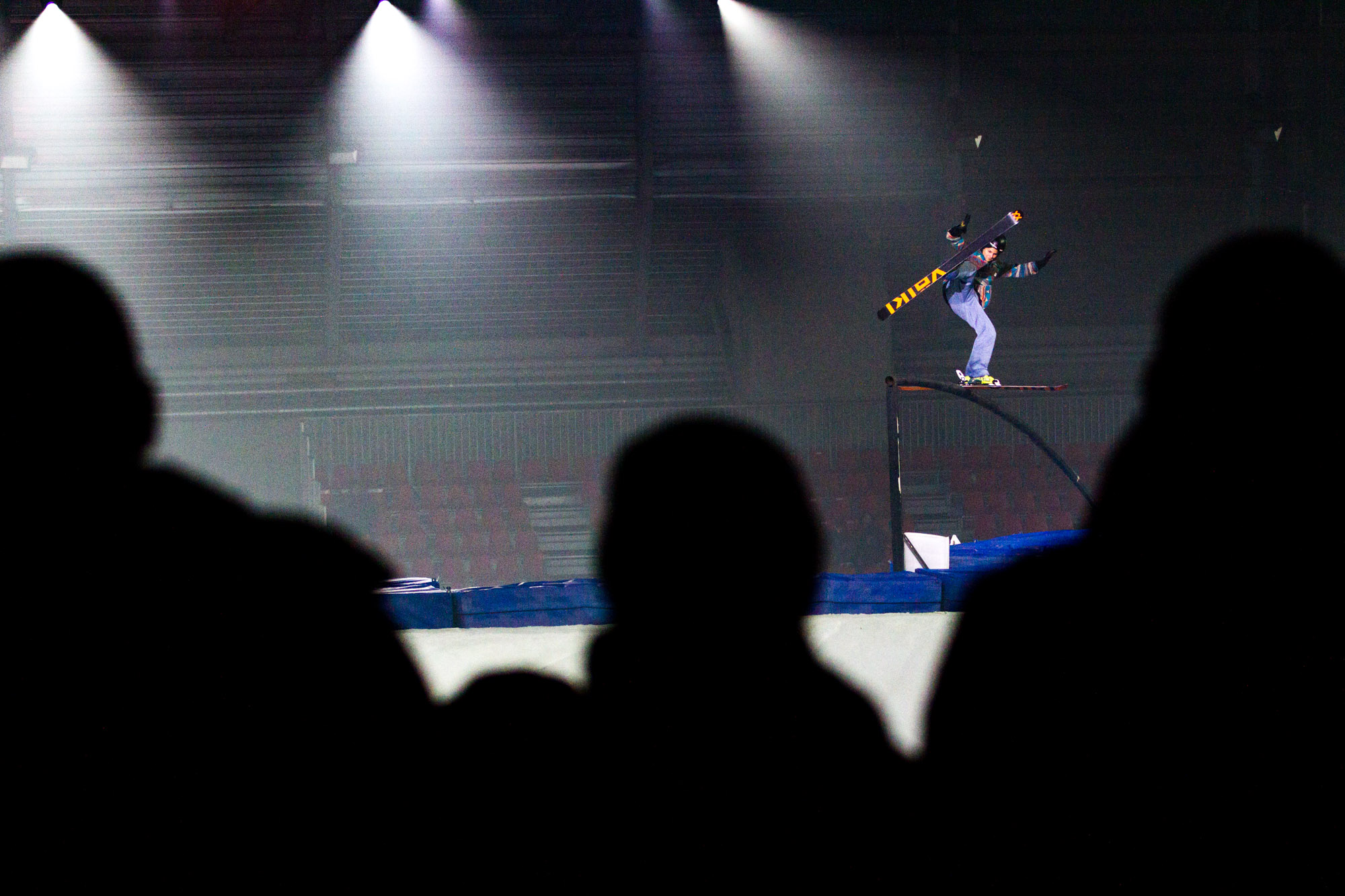
I´d call this a respectable backslide from Coline Ballet-Baz, wouldn´t you?
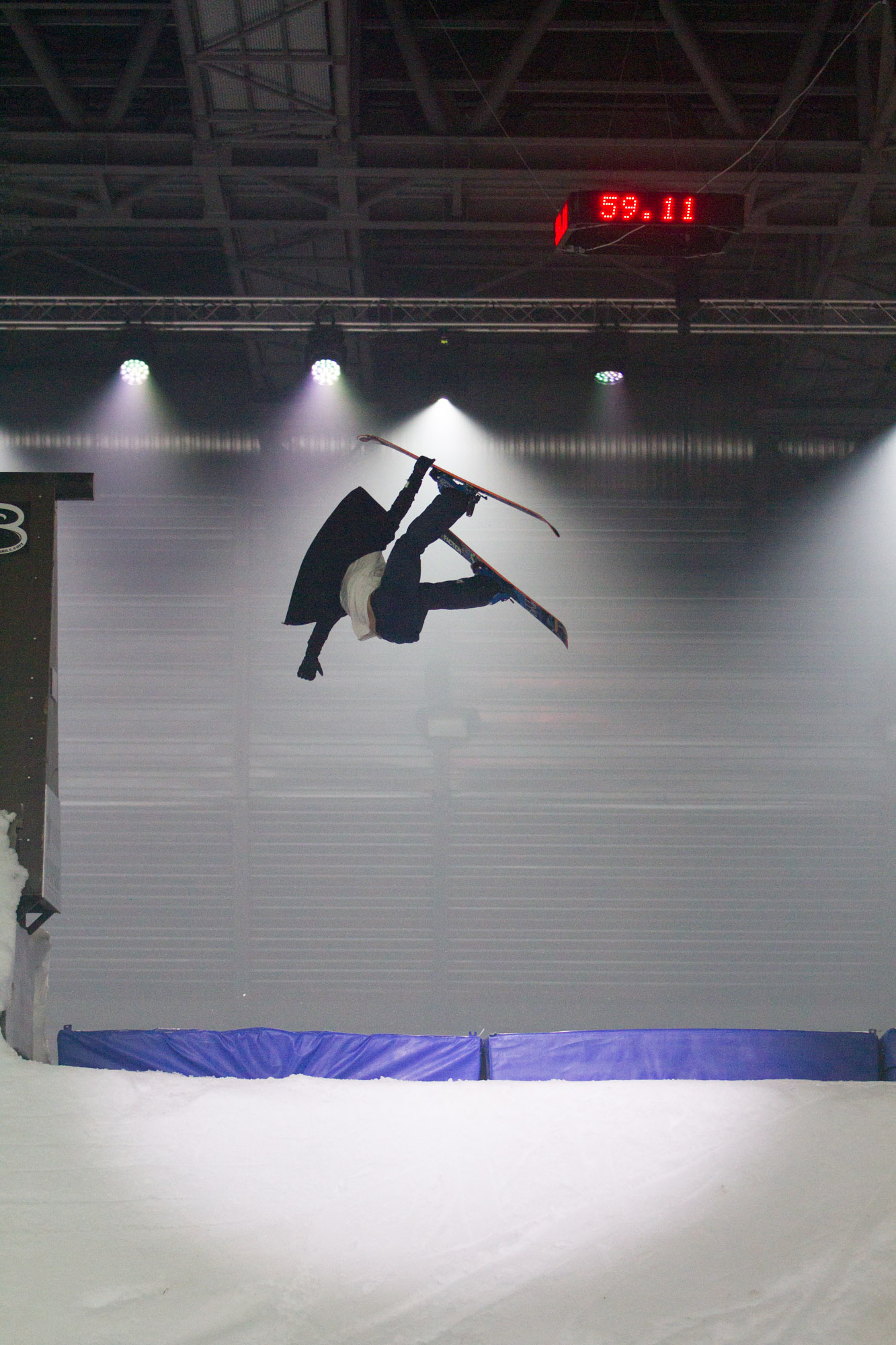
Hoefflin looking right at home for her first time using a winch setup.
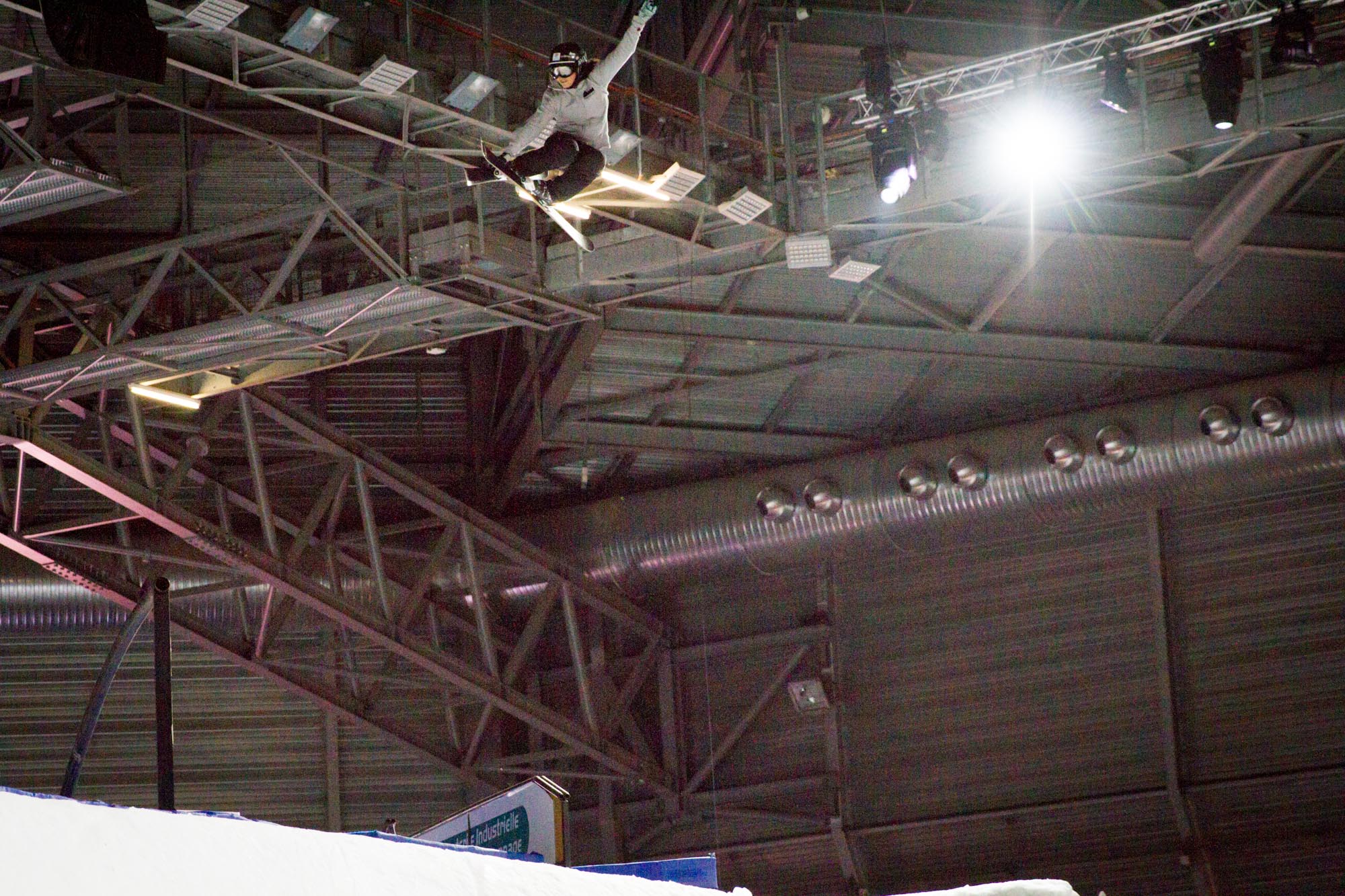
Marie Martinod trying to jump out of the frame.
“This was the coolest, most original event of the year,” said Hoefflin. “It’s so different, the crowd and the riders. I’m not used to riding with some of the guys who aren’t on the World Cup tour, so it’s nice to see some different faces. It’s a different vibe for sure, really chilled out. We actually decided not to make it a competition and split the prize money equally.”
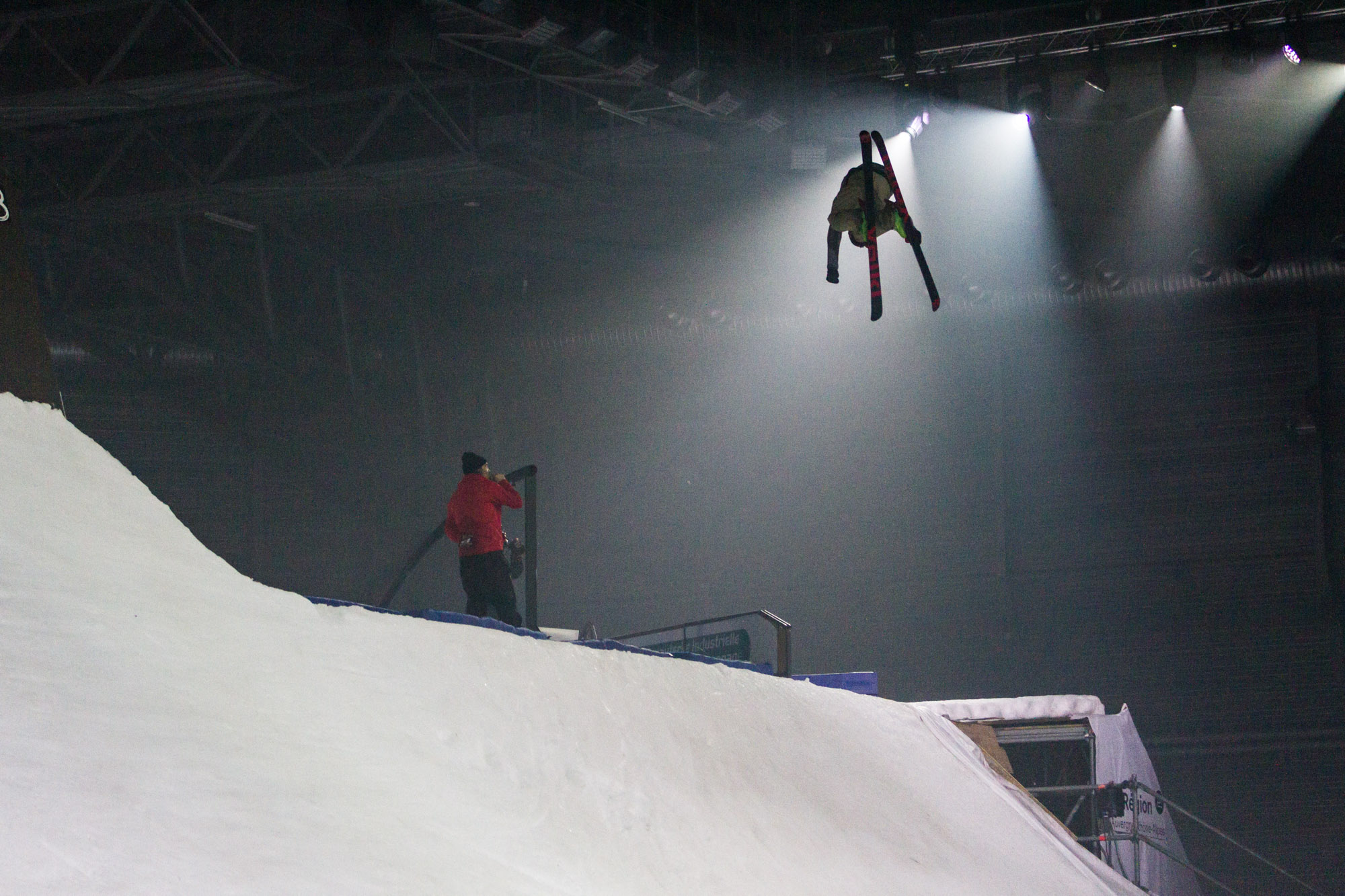
Tom Ritsch flying Austrian Airlines.
“It was so fun to finally do an event inside an arena like this where weather isn’t an issue,” said Henrik Harlaut, who didn’t make finals but whose presence was still a major draw for the crowd. “We always deal with wind and temperature changes and stuff, so it was wicked to not have that as an issue at all.”
“I’m so happy they created this and I hope we get to see more events like this in the future,” Harlaut continued. “It’s really cool for the spectators to get so close to the features. It’s a different feeling; like a bullfight arena, with everyone cheering and stomping. It’s a great feeling to ski in front of so many people that close.”
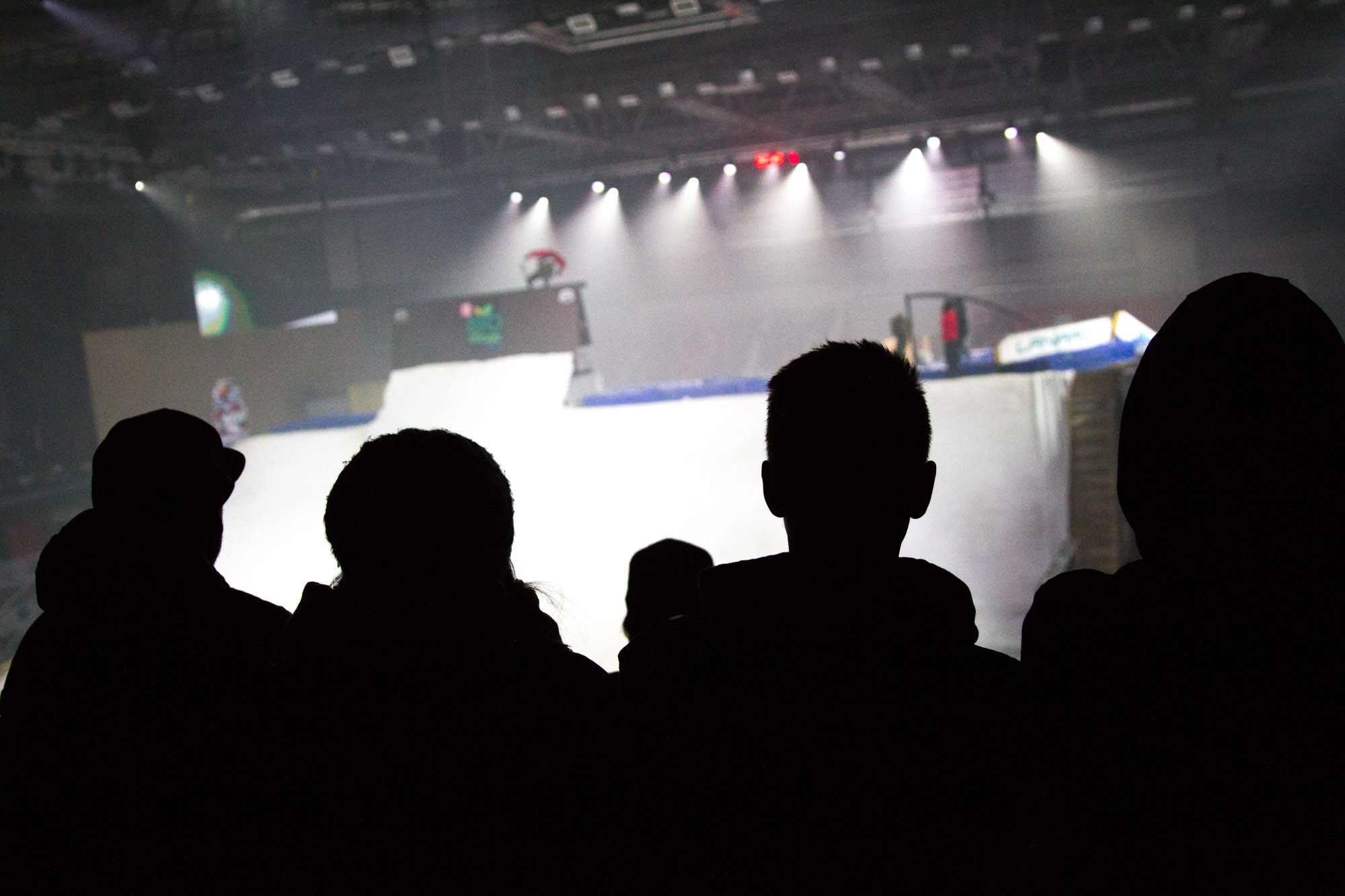
“We didn’t want to have a contest with a normal format or a FIS World Cup event,” said Regazzoni. “We wanted to keep it creative because we need these events. If you look at the calendar of events, it’s like 90% of the events are being run by FIS. We’re kind of losing our soul—not fully, but kind of. And we need to keep the vibe up with events like this, with a such a unique crew of riders, because that’s the soul of our sport.”
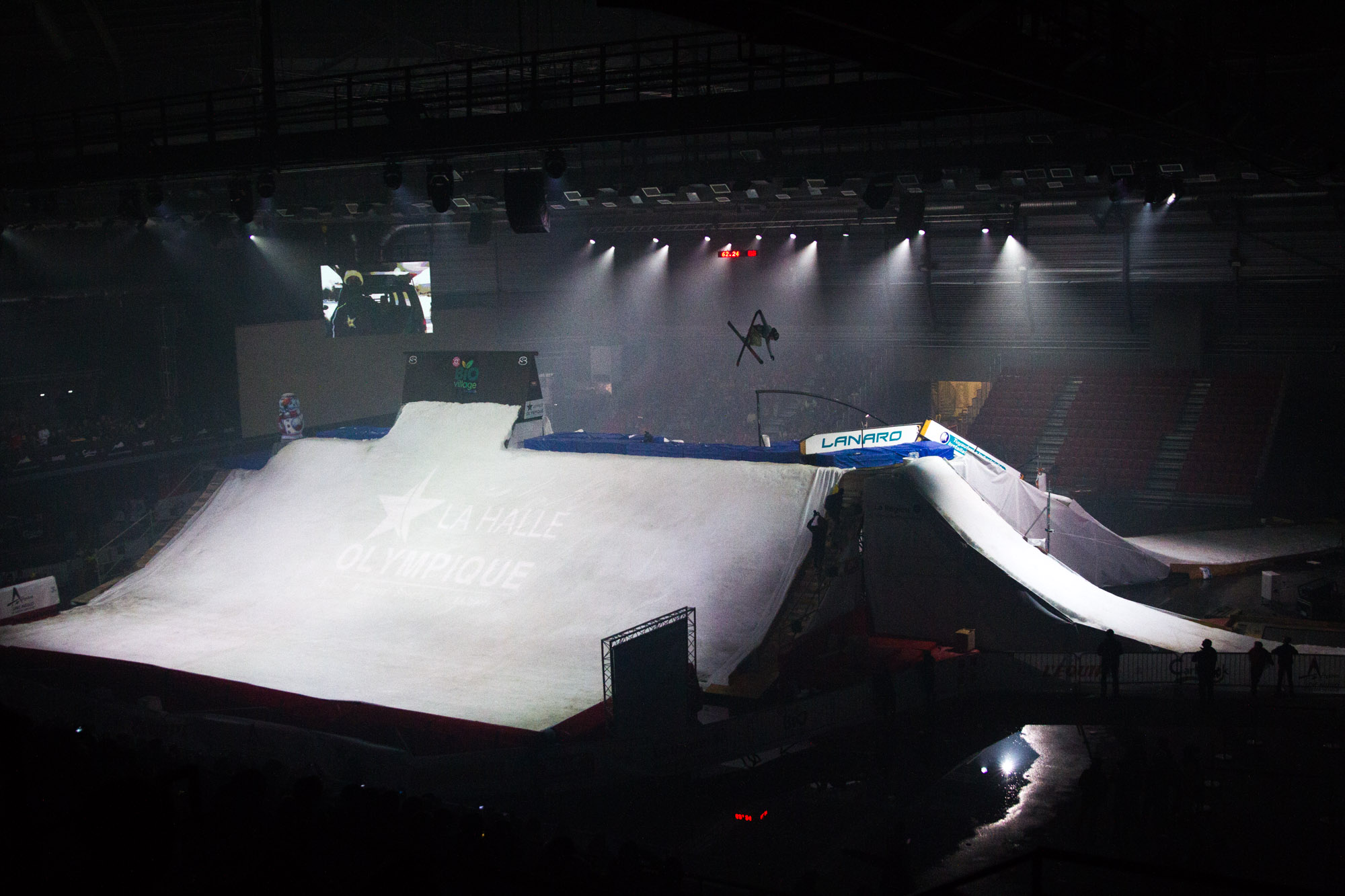
Tom Ritsch, 360 blunt.